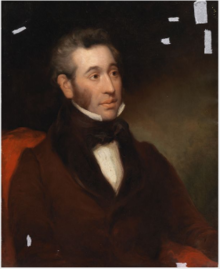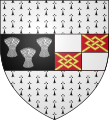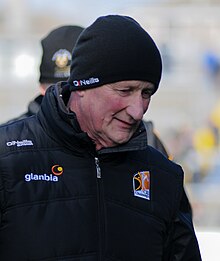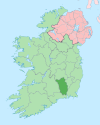The County Kilkenny Portal
County Kilkenny (Irish: Contae Chill Chainnigh) is a county in Ireland. It is in the province of Leinster and is part of the Southern Region. It is named after the city of Kilkenny. Kilkenny County Council is the local authority for the county. At the 2022 census the population of the county was 103,685. The county was based on the historic Gaelic kingdom of Ossory (Osraighe), which was coterminous with the Diocese of Ossory. (Full article...)
Selected articles

Kilkenny (Irish: Cill Chainnigh [ˌciːl̠ʲ ˈxan̠ʲəj], meaning 'church of Cainnech') is a city in County Kilkenny, Ireland. It is located in the South-East Region and in the province of Leinster. It is built on both banks of the River Nore. The 2022 census gave the population of Kilkenny as 27,184, the thirteenth-largest urban center in Ireland.
Kilkenny is a tourist destination, and its environs include historic buildings such as Kilkenny Castle, St Canice's Cathedral and round tower, Rothe House, Shee Alms House, Black Abbey, St. Mary's Cathedral, The Tholsel, St. Francis Abbey, Grace's Castle, and St. John's Priory. Kilkenny is also known for its craft and design workshops, the Watergate Theatre, public gardens and museums. Annual events include Kilkenny Arts Festival, the Cat Laughs comedy festival and music at the Kilkenny Roots Festival.
Kilkenny began with an early 6th-century ecclesiastical foundation within the Kingdom of Ossory. Following the 12th-century Norman invasion of Ireland, Kilkenny Castle and a series of walls were built to protect the burghers of what became a Norman merchant town. William Marshall, Lord of Leinster, gave Kilkenny a charter as a town in 1207. By the late 13th century, Kilkenny was under Hiberno-Norman control. The Statutes of Kilkenny, passed at Kilkenny in 1367, aimed to curb the decline of the Hiberno-Norman Lordship of Ireland. In 1609, King James I of England granted Kilkenny a Royal Charter, giving it the status of a city. Following the Irish Rebellion of 1641, the Irish Catholic Confederation, also known as the "Confederation of Kilkenny", was based in Kilkenny and lasted until the Cromwellian conquest of Ireland in 1649. From 1840 onwards, Kilkenny has not been administered as a city under local government law, but the Local Government Reform Act 2014 provides for "the continued use of the description city". (Full article...)
Selected history articles

The peerage title Earl of Ormond and the related titles Duke of Ormonde and Marquess of Ormonde have a long and complex history. An earldom of Ormond has been created three times in the Peerage of Ireland. (Full article...)
Selected landmarks articles

Rothe House /ˈroʊθ/ is a late 16th-century merchant's townhouse complex located in the city of Kilkenny, Ireland. The complex was built by John Rothe Fitz-Piers between 1594–1610 and is made up of three houses, three enclosed courtyards, and a large reconstructed garden with orchard. As a museum, it is accessible to the public.
Rothe House is the only remaining example of a complete burgage plot in Ireland, and considered to be nationally significant because of the range of original post-medieval features that survive. The property, an important element of Kilkenny's heritage, is owned by the Kilkenny Archaeological Society and houses some of the society's collection of artefacts relating to Kilkenny City, County and Ireland.
The garden to the rear of the house has been reconstructed to reflect a typical 17th-century garden. It features a well dug by Cistercian monks (based in Duiske Abbey in Graiguenamagh) who owned the property before the dissolution of monasteries. The burgage plot on which Rothe House was built survives intact – one of a few in such an unaltered state. Kilkenny's medieval city wall forms part of the curtilage of the Rothe House complex. (Full article...)
Selected geography articles
The barony of Callan (Irish: Callainn, meaning "Callow land") is a barony in the west of County Kilkenny, Ireland. The barony is 22.9 square kilometres (8.8 sq mi) in size. It is one of 12 baronies in County Kilkenny. Unusually for a barony, it contains only two civil parishes which together comprise 65 townlands. The chief town is Callan. The barony is bordered by the baronies of Shillelogher to the north (whose chief town is Bennettsbridge) and by Kells to the south (whose chief town is Kells). The N76 road bisects the barony. Notable features include Callan Motte and Callan Augustinian Friary. (Full article...)
Ballyhale (Irish: Baile Héil) is a village in the south east of Ireland. Located in the south of County Kilkenny, south of the city of Kilkenny and roughly halfway to Waterford city. (Full article...)
The River Suir (/ʃʊər/ SHOOR; Irish: an tSiúr [ənʲ ˈtʲuːɾˠ] or Abhainn na Siúire [ˌəun̠ʲ n̪ˠə ˈʃuːɾʲə]) is a river in Ireland that flows into the Atlantic Ocean through Waterford after a distance of 185 kilometres (115 mi). The catchment area of the Suir is 3,610 km2. Its long term average flow rate is 76.9 cubic metres per second (m3/s), about twice the flow of either the River Barrow (37.4 m3/s) or the River Nore (42.9 m3/s) before these join, but a little less than the Barrow's flow when it meets the Suir 20 km downstream (over 80 m3/s). (Full article...)

Jenkinstown Park is a park in County Kilkenny, Ireland. It is situated off the N78 road about 10 km north of the city of Kilkenny and 11 km south of Castlecomer. (Full article...)
Selected quotation
There once was two cats of Kilkenny Each cat thought there was one cat too many So they fought and they fit And they scratched and they bit 'Til instead of two cats there weren't any. | — |
Selected Did you know

- ... that Kilkenny (pictured) gets its name from Cainnech of Aghaboe?
- ... that the River Nore flows through County Kilkenny and Kilkenny? (Full article...)
Selected slideshow image
Selected biography articles

John Banim (3 April 1798 – 30 August 1842), was an Irish novelist, short story writer, dramatist, poet and essayist, sometimes called the "Scott of Ireland." He also studied art, working as a painter of miniatures and portraits, and as a drawing teacher, before dedicating himself to literature. (Full article...)
Abraham Colles (23 July 1773 – 16 November 1843) was Professor of Anatomy, Surgery and Physiology at the Royal College of Surgeons in Ireland (RCSI) and the President of RCSI in 1802 and 1830. A prestigious Colles Medal & Travelling Fellowship in Surgery is awarded competitively annually to an Irish surgical trainee embarking on higher specialist training abroad before returning to establish practice in Ireland. (Full article...)
Colm Ó Lochlainn (1892 – 26 June 1972) was an Irish printer, typographer, collector of Irish ballads and traditional Irish Uilleann piper. He was notably the author of Irish Street Ballads published in 1939 and More Irish Street Ballads in 1965. (Full article...)
Brian Mac Giolla Phádraig (c. 1580 – 1653) was an Irish poet and priest. He is not to be confused with any of the Barons of Upper Ossory, his relations, several of whom bore the same name in Irish. (Full article...)
Selected sport articles
Brian Cody (born 12 July 1954) is an Irish former hurling manager and player and retired school principal. He managed the senior Kilkenny county team between 1998 and 2022, becoming the county's longest-serving manager and most successful in terms of major titles won. Cody is regarded as the greatest manager in the history of the game.
Cody was appointed manager of the Kilkenny senior team on 16 November 1998 and led Kilkenny through a period of unprecedented provincial and national dominance, winning 43 major honours. These include eleven All-Ireland Senior Hurling Championship titles, including a record-equalling four-in-a-row between 2006 and 2009, seventeen Leinster Senior Hurling Championship titles in twenty three seasons, ten National Hurling League titles (among which were five league-championship doubles) and seven Walsh Cups. He left at the end of the 2022 season. (Full article...)
Related portals
Associated Wikimedia
The following Wikimedia Foundation sister projects provide more on this subject:
- Commons
Free media repository - Wikibooks
Free textbooks and manuals - Wikidata
Free knowledge base - Wikinews
Free-content news - Wikiquote
Collection of quotations - Wikisource
Free-content library - Wikiversity
Free learning tools - Wikivoyage
Free travel guide - Wiktionary
Dictionary and thesaurus





























































